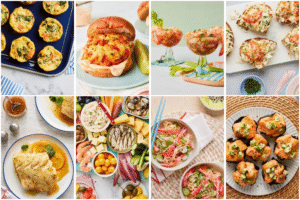Monkfish: Cooking, and Nutrition
Monkfish, often referred to as the “poor man’s lobster,” is a seafood delicacy cherished for its firm texture, rich flavor, and incredible versatility. This extraordinary fish has captivated chefs and home cooks worldwide with its ability to transform any dish into a gourmet masterpiece.
In this comprehensive guide, we’ll explore everything you need to know about monkfish, from selecting the freshest catch to preparing exquisite meals that highlight its unique qualities.
What Is Monkfish?
Monkfish is a bottom-dwelling predator found in the Atlantic Ocean, known for its distinctive appearance and culinary appeal. While its large head and flattened body may not win beauty contests, its tail meat is the real treasure. Monkfish boasts a sweet, lobster-like flavor and a firm, meaty texture, making it a favorite in cuisines around the globe.
Global Popularity of Monkfish
Monkfish has earned its place in the culinary traditions of many cultures:
- Asian Cuisine: Often served in spicy curries or stir-fries.
- European Dishes: Commonly paired with garlic cream sauces or roasted vegetables.
- American Menus: Increasingly featured as a grilled or pan-seared delicacy in fine dining.
Selecting the Perfect Monkfish
Choosing high-quality monkfish ensures the best flavor and texture for your dishes. Here’s what to look for:
1. Size
Monkfish tails can range from 1 to 10 pounds. Smaller tails are ideal for quick cooking methods like grilling or sautéing, while larger tails are perfect for hearty roasts or stews.
2. Firmness
Fresh monkfish should feel firm to the touch, with a slightly springy texture. Avoid fish with soft or mushy flesh, as this indicates poor handling or age.
3. Color
The flesh should be a creamy white to light pink color. Discoloration or dark spots are signs of age or improper storage.
Preparing Monkfish: Tips and Techniques
Monkfish is versatile and easy to prepare with a few key tips:
1. Cleaning and Defrosting
- Defrosting: Slowly thaw frozen monkfish overnight in the refrigerator or under cold running water for faster results.
- Cleaning: Rinse the fish under cold water and pat it dry. Remove any membranes or excess moisture for even cooking.
2. Cooking Methods
Monkfish adapts to various cooking techniques:
- Grilling: Enhances its natural sweetness with a smoky char.
- Baking: Preserves its moisture while infusing it with flavors like garlic or herbs.
- Pan-Searing: Creates a golden crust for a rich, savory finish.
- Steaming: Retains its delicate flavor, perfect for light sauces.
Pro Tip: Cook monkfish to an internal temperature of 145°F to ensure it’s thoroughly cooked.
Irresistible Monkfish Recipes
1. Garlic Butter Monkfish
Ingredients:
- 2 lbs monkfish tail
- 4 tbsp unsalted butter
- 2 cloves garlic, minced
- Fresh parsley for garnish
Instructions:
- Heat butter in a skillet over medium heat. Add garlic and sauté until fragrant.
- Add monkfish and cook for 3–4 minutes per side until golden brown.
- Garnish with parsley and serve with roasted vegetables.
2. Monkfish Stew with Tomatoes and White Wine
Ingredients:
- 2 lbs monkfish, cut into chunks
- 1 can diced tomatoes
- 1 cup white wine
- 1 onion, diced
- Fresh basil for garnish
Instructions:
- Sauté onion in olive oil until translucent. Add tomatoes and white wine, simmering for 10 minutes.
- Add monkfish and cook for 7–10 minutes until tender.
- Garnish with basil and serve with crusty bread.
3. Grilled Monkfish with Lemon Herb Marinade
Ingredients:
- 2 lbs monkfish tail
- Juice of 2 lemons
- 2 tbsp olive oil
- 1 tsp dried oregano
Instructions:
- Combine lemon juice, olive oil, and oregano. Marinate monkfish for 30 minutes.
- Grill over medium heat for 4–5 minutes per side until charred.
- Serve with a side of steamed asparagus or wild rice.
For step-by-step cooking tutorials, visit our YouTube Channel.
Storing Monkfish
Proper storage preserves the freshness and quality of monkfish:
1. Refrigeration
Store monkfish in an airtight container or wrap it tightly in plastic. Keep it in the coldest part of the refrigerator and use it within 2–3 days.
2. Freezing
For long-term storage, freeze monkfish in vacuum-sealed bags or heavy-duty freezer wraps. Monkfish remains fresh for up to 3 months in the freezer.
Nutritional Benefits of Monkfish
Monkfish is not just delicious—it’s packed with essential nutrients:
| Nutrient | Amount (Per 3.5 oz) | Health Benefit |
|---|---|---|
| Protein | 26 g | Supports muscle growth and repair. |
| Omega-3 Fatty Acids | 0.5 g | Promotes heart and brain health. |
| Vitamin B12 | 2.1 mcg | Boosts energy and supports nerve function. |
| Potassium | 300 mg | Maintains healthy blood pressure levels. |
Did You Know? Monkfish is naturally low in fat and carbohydrates, making it an ideal choice for health-conscious diets.
FAQs About Monkfish
1. Is monkfish sustainable?
Monkfish is managed under strict fishing regulations in the U.S. and Europe, ensuring sustainable harvesting.
2. Can I substitute monkfish in recipes?
Yes, monkfish can be replaced with similar firm white fish like Pacific cod, lingcod, or halibut.
3. How do I know if monkfish is cooked?
Cooked monkfish will be opaque and flake easily with a fork.
Shop Fresh Seafood at Global Seafoods
Bring the flavors of the ocean to your kitchen with our premium seafood:
- Alaskan Pollock Fillets
- Pacific Cod Fillets
- Lingcod Fillets
Conclusion
Monkfish is a true culinary treasure, offering unparalleled flavor, texture, and versatility. From simple weeknight meals to elegant gourmet dishes, monkfish adapts effortlessly to any cooking style. Packed with nutrients and easy to prepare, it’s no wonder monkfish has earned its place as one of the most sought-after seafoods in the world.
Shop premium monkfish and other fresh seafood at Global Seafoods to start your culinary journey today!



